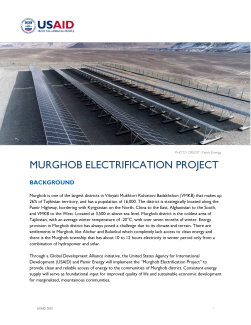2022 - 2024 | Pamir Energy Company | $4,150,000
BACKGROUND
Murghob is one of the largest districts in Viloyati Mukhtori Kuhistoni Badakhshon (VMKB) that makes up 26% of Tajikistan territory, and has a population of 16,000. The district is strategically located along the Pamir Highway, bordering with Kyrgyzstan on the North, China to the East, Afghanistan to the South, and VMKB to the West. Located at 3,500 m above sea level. Murghob district is the coldest area of Tajikistan, with an average winter temperature of -20°C, with over seven months of winter. Energy provision in Murghob district has always posed a challenge due to its climate and terrain. There are settlements in Murghob, like Alichur and Bulunkul which completely lack access to clean energy and there is the Murghob township that has about 10 to 12 hours electricity in winter period only from a combination of hydropower and solar.
Through a Global Development Alliance initiative, the United States Agency for International Development (USAID) and Pamir Energy will implement the “Murghob Electrification Project” to provide clean and reliable access of energy to the communities of Murghob district. Consistent energy supply will serve as foundational input for improved quality of life and sustainable economic development for marginalized, mountainous communities.
GOALS
The project aims to improve the quality of life of the residents of Murgab district by providing access to sustainable and reliable sources of energy by upgrading the capacity of the existing 200kW solar power plant and installation of an additional battery energy storage capacity.
OBJECTIVE ONE
Improve access to affordable and reliable off-grid renewable energy in Murgab township and Alichur settlement. Upgrade the capacity of existing 200kW SPP by adding additional 600 KW and install 1.2 MWh of battery energy system storage (BESS) in Murgab Township.
OBJECTIVE TWO
Improve access of energy to new commercial and governmental institutions. This include developing transmission lines to new commercial and governmental organizations and in some cases providing indoor wiring in locations that have not previously been electrified.
OBJECTIVE THREE
Reduce dependency on fossil fuel and energy related carbon dioxide (CO2) emissions by substituting fossil fuel with renewable energy sources such as Solar PV and battery energy system storage (BESS).
ANTICIPATED RESULTS
- Improved access to reliable and clean energy
- Reduced dependency on biofuels and fossil fuels.
- High-quality and resilient infrastructure (new distribution lines and dual method power supply) in place to combat against climate change.
- Increased socio-economic development activities.
- Improved access to education and health services.


